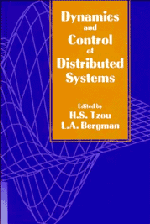Book contents
- Frontmatter
- Contents
- Contributors
- Preface
- 1 On the Transient Response of Distributed Structures Interacting with Discrete Components
- 2 On the Problem of a Distributed Parameter System Carrying a Moving Oscillator
- 3 Nonlinear Normal Modes and Wave Transmission in a Class of Periodic Continuous Systems
- 4 Dynamics and Control of Articulated Anisotropic Timoshenko Beams
- 5 Numerical Techniques for Simulation, Parameter Estimation, and Noise Control in Structural Acoustic Systems
- 6 Distributed Transfer Function Analysis of Stepped and Ring-stiffened Cylindrical Shells
- 7 Orthogonal Sensing and Control of Continua with Distributed Transducers – Distributed Structronic System
- Index
2 - On the Problem of a Distributed Parameter System Carrying a Moving Oscillator
Published online by Cambridge University Press: 12 October 2009
- Frontmatter
- Contents
- Contributors
- Preface
- 1 On the Transient Response of Distributed Structures Interacting with Discrete Components
- 2 On the Problem of a Distributed Parameter System Carrying a Moving Oscillator
- 3 Nonlinear Normal Modes and Wave Transmission in a Class of Periodic Continuous Systems
- 4 Dynamics and Control of Articulated Anisotropic Timoshenko Beams
- 5 Numerical Techniques for Simulation, Parameter Estimation, and Noise Control in Structural Acoustic Systems
- 6 Distributed Transfer Function Analysis of Stepped and Ring-stiffened Cylindrical Shells
- 7 Orthogonal Sensing and Control of Continua with Distributed Transducers – Distributed Structronic System
- Index
Summary
Abstract
The problem of an elastic distributed system coupled with a moving oscillator, often referred to as the “moving-oscillator” problem, is studied in this chapter. The problem is formulated using a “relative displacement” model. It is shown that, in the limiting case, the moving-mass problem is recovered. The coupled equations of motion are recast into an integral equation, which is amenable to solution by both iterative and direct numerical procedures. The response of a string with a moving oscillator is studied using the direct numerical method.
Introduction
Perspective
The prediction of the dynamic response of a distributed elastic system that supports one or more translating elastic subsystems has been a fundamental problem of interest for well over a century. Interest in this problem originates in structural engineering for the design of railroad tracks, railroad bridges, and highway bridges, wherein the accurate calculation of loads is essential for reliable design and accurate life prediction (Stokes, 1883; Ting and Yener, 1983; Tan and Shore, 1968). It has been observed that, as a structure is subjected to moving loads, the dynamic deflection and stresses can be significantly higher than those observed in the static case. Hence, strict design criteria are now required as structural engineers become more aggressive in the use of long, flexible spans in cable-stayed and suspension bridges and compliant bearings in highway bridges to accommodate environmental loads.
Information
- Type
- Chapter
- Information
- Dynamics and Control of Distributed Systems , pp. 69 - 94Publisher: Cambridge University PressPrint publication year: 1998
Accessibility standard: Unknown
Why this information is here
This section outlines the accessibility features of this content - including support for screen readers, full keyboard navigation and high-contrast display options. This may not be relevant for you.Accessibility Information
- 10
- Cited by
